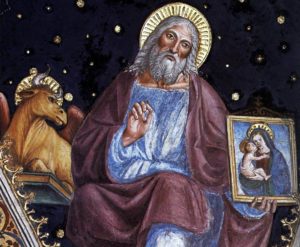Festival of St. Luke, Evangelist
October 18
The Lord be with you
October 18 is the Festival of St. Luke, Evangelist. St. Luke, the beloved physician referred to by St. Paul (Colossians 4:14), presents us with Jesus, whose blood provides the medicine of immortality. He was a Gentile, probably a Greek. As Paul’s traveling companion, he claimed Luke’s Gospel as his own for its healing of souls (Eusebius). Luke traveled with Paul during the second missionary journey, joining him after Paul received his Macedonian call to bring the Gospel to Europe (Acts 16:10-17). Luk e most likely stayed behind in Philippi for seven years, rejoining Paul at the end of the third missionary journey in Macedonia. He traveled with Paul to Troas, Jerusalem, and Caesarea, where Paul was imprisoned for two years (Acts 20:5-21:18). While in Caesarea, Luke may have researched material that he used in his Gospel. Afterward, Luke accompanied Paul on his journey to Rome (Acts 27:1-28:16). Especially loved in Luke’s Gospel are the stories of the Good Samaritan (Luke 10:29-37), the prodigal son (Luke 15:11-32), the rich man and Lazarus (Luke 16:19-31), and the Pharisee and the tax collector (Luke 18:9-14). Only Luke provides a detailed account of Christ’s birth (Luke 2:1-20) and the canticles of Mary (Luke 1:46-35), of Zechariah (Luke 1:68-79), and of Simeon (Luke 2:29-32). To show how Christ continued His work in the Early Church through the Apostles, Luke also penned the Acts of the Apostles. More than one-third of the New Testament comes from the hand of the evangelist Luke.
e most likely stayed behind in Philippi for seven years, rejoining Paul at the end of the third missionary journey in Macedonia. He traveled with Paul to Troas, Jerusalem, and Caesarea, where Paul was imprisoned for two years (Acts 20:5-21:18). While in Caesarea, Luke may have researched material that he used in his Gospel. Afterward, Luke accompanied Paul on his journey to Rome (Acts 27:1-28:16). Especially loved in Luke’s Gospel are the stories of the Good Samaritan (Luke 10:29-37), the prodigal son (Luke 15:11-32), the rich man and Lazarus (Luke 16:19-31), and the Pharisee and the tax collector (Luke 18:9-14). Only Luke provides a detailed account of Christ’s birth (Luke 2:1-20) and the canticles of Mary (Luke 1:46-35), of Zechariah (Luke 1:68-79), and of Simeon (Luke 2:29-32). To show how Christ continued His work in the Early Church through the Apostles, Luke also penned the Acts of the Apostles. More than one-third of the New Testament comes from the hand of the evangelist Luke.
A later tradition says that he was also a painter and painted a portrait of the Virgin Mary, but it seems unreliable. Nonetheless, it is an important inspiration for the art form of Icons. St. Luke is said to have died at the age of eighty-four, having never married. There are various locations given in various traditions for the location of his death: Boetia, Egypt, Bithynia and Achaia. The date of October 18 for his festival is very ancient and may actually reflect the day he died.
The traditional symbol for St Luke is the ox and is drawn from Ezekiel 1:10. It might remind us of the beginning of Luke’s Gospel. There we read both about how Zachariah, the priest and father of John the Baptist, was in the temple performing his duties when an angel appeared to him. Priests, of course, sacrificed animals. We also read of how Jesus was born and the feeding trough (manger) of the animals (like an ox) was used for our Lord’s crib. Finally, the ox might remind us that Jesus was sacrificed for our sins.
Collect of the Festival of St. Luke, Evangelist: Almighty God, our Father, Your blessed Son called Luke the physician to be an evangelist and physician of the soul. Grant that the healing medicine of the Gospel and the Sacraments may put to flight the diseases of our souls that with willing hearts we may ever love and serve You; through Jesus Christ, Your Son, our Lord, who lives and with You and the Holy Spirit, one God, now and forever. Amen.
Other things you may wish to pray about:
• For the sick
• For doctors and all the healing professions
• For hospitals and nursing homes
• For artists
• For compassion
• For the spread of the Gospel
Blessings in Christ,
Pastor John Rickert
